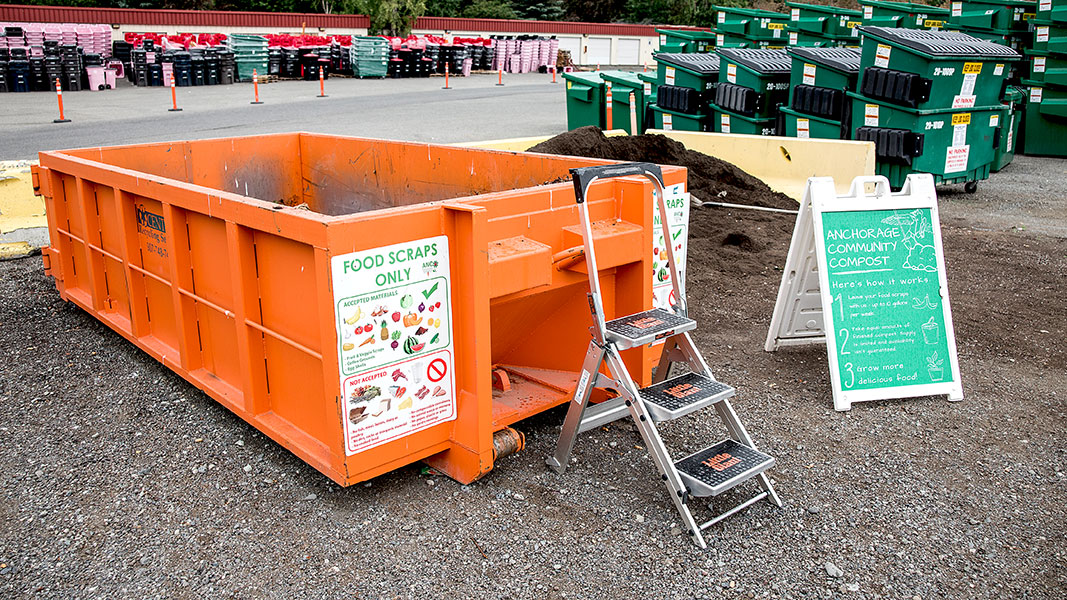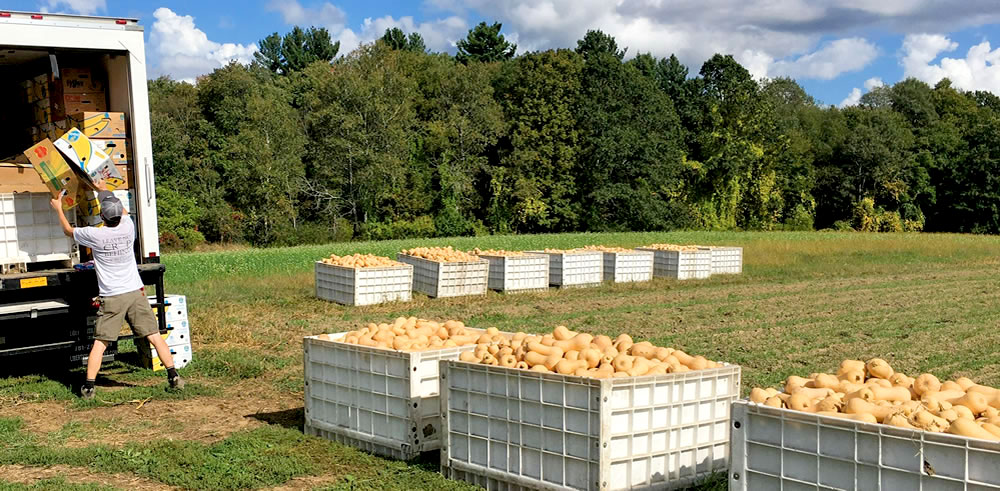Top: This drop-off site in Anchorage was funded under a USDA community compost grant program, established in the 2018 Farm Bill. Photo courtesy of Solid Waste Services—Municipality of Anchorage.
Nora Goldstein
Ten years in from the first time they were publicized, little has changed in the dismal statistics that Americans waste a third of the food produced or imported in the United States every year. According to the Harvard Law School Food Law and Policy Clinic (FLPC), “producing this wasted food consumes around 20% of fresh water and cropland and generates around 270 million metric tons of greenhouse gas emissions annually, the same as 58 million cars.”
Over the last decade, organizations like FLPC have made a lot of headway in bringing attention to the policy changes needed to reduce the amount of food wasted in the U.S. For example, notes FLPC, the 2018 Farm Bill prioritized food waste for the first time. Several food waste reduction interventions were in the bill, such as including clarifying liability protections for food donors, financing food recovery from farms, encouraging food waste recycling through community composting funding, and better coordinating food waste reduction efforts across the federal government.
The 2023 Farm Bill, to be drafted by various Congressional committees over the coming months, poses “a remarkable opportunity” for Congress to prevent food waste, recover edible food for individuals in need, and fight climate change, states FLPC in its newly released report, “Opportunities to Reduce Food Waste in the 2023 Farm Bill.” The Clinic collaborated with ReFED, NRDC (Natural Resources Defense Council), and World Wildlife Fund on the advocacy paper, which details how Congress can build off of the 2018 Farm Bill and better prioritize food waste reduction. “Initiatives that target food waste could generate $73 billion in annual financial benefits, recover the equivalent of four billion meals for those in need, save four trillion gallons of water, and eliminate 75 million tons of greenhouse gas emissions annually,” stated the press release. “Prioritizing food waste reduction has bipartisan support, thanks to its economic, social, and environmental benefits.”
“Opportunities to Reduce Food Waste in the 2023 Farm Bill” outlines 22 actionable recommendations focusing on food waste reduction, surplus food recovery, food waste recycling, and how the federal government could encourage inter-governmental coordination on food waste issues. Each recommendation details a food waste reduction opportunity that Congress and federal agencies can adopt. Policy recommendations are made that build upon established programs based on stakeholder feedback and subject matter experts on a variety of food policies in the United States.
Prevention, Recovery, Recycling — And Collaboration
Recommended actions are divided into four categories, based on whether they are intended to prevent food waste, increase food recovery, recycle food scraps through composting or anaerobic digestion, or coordinate food waste reduction efforts. Mentions of pending federal legislation, where it exists, are included. As a reviewer of the draft report, I was impressed by the specificity of policy recommendations within each individual action. Examples, excerpted from the report, include:
- Standardizing and Clarifying Date Labels: FLPC, NRDC, ReFED, WWF and others have been pursuing changes in date labeling language for a number of years. This is a low-cost policy action that can yield significant food waste reduction benefits. The report recommends that standardization should take the form of the two labels: “BEST if Used By” to indicate quality, and “USE By” to indicate safety. The initiative should also include a consumer education campaign. The farm bill has previously addressed food labeling concerns, and is an appropriate vehicle for standardizing date labels. This scheme should be implemented through a new Food Waste Reduction Title or in the Miscellaneous Title. Language implementing the above recommendations could be taken from the bicameral, bipartisan Food Date Labeling Act of 2021.
- Leveraging Existing Food Waste Reduction Tools: The U.S. EPA has resources and guides to help consumers reduce wasted food, but the agency has not taken the steps necessary, e.g., through a campaign, to effectively reduce food waste nationally. “The next farm bill should instruct the USDA, in collaboration with EPA, to launch a national food waste education and awareness campaign,” states this recommendation. “A widespread consumer education campaign should be supported with funds appropriated through a Food Waste Reduction Title or through the Miscellaneous Title. Congress should appropriate $7 million annually through 2030, with $3 million for research into effective consumer food waste reduction strategies and $4 million into consumer behavior change campaigns.”
- Better Support For Gleaning: Gleaning has the annual potential to divert 78,500 tons of food waste and save 2.14 billion gallons of water, with a net financial benefit of $152 million, says the report. It explains that the USDA Risk Management Agency (RMA) permits and encourages farmers to donate damaged crops for gleaning purposes while still allowing farmers to receive insurance compensation for their lost crops. Despite policies that allow for gleaning, few farmers take advantage of these policies due to a deficit in knowledge around gleaning opportunities, notes the report: “Congress should require the USDA to develop and disseminate semi-annual information sheets or reminder notices to farmers, crop insurance agents, RMA agents, and gleaning organizations. … This guidance, in addition to increasing awareness of gleaning as an option, should clarify how crop insurance allows for gleaning (to this, it should explain that crop insurance can still be collected if farmers allow for gleaning), clarify that farmers can still claim tax incentives for donated food in addition to crop insurance, and clarify that farmers can receive payment for non-crop expenses associated with gleaning (i.e., transportation, labor).” The guidance should also provide contact information for local gleaning organizations for each farmer to the extent possible and ensure that farmers are aware that they are protected from liability claims regarding both the safety of the food gleaned and for any injuries sustained by volunteers on their land under the Emerson Act.
- State and Local Capacity Building: The report discusses the effectiveness of state and local policies and initiatives to address food waste. It recommends that the next farm bill should “provide grants to state and local governments, and to public-private partnerships, to encourage them to implement proven or promising food waste reduction policies, such as organic waste bans, mandatory recycling laws, landfill taxes, Pay-As-You-Throw laws, and other policy measures to make it comparatively costlier or more difficult to send food to landfills or incinerators.” To accelerate the adoption of these strategies, the authors say the farm bill should “provide $650 million/year for 10 years for state, local, and tribal governments, independently or as part of a public-private partnership, to plan or implement an organic waste ban or other proven food waste reduction policy. As part of this program, Congress should require the USDA (in collaboration with the EPA) to maintain a database of the state and local food waste reduction policies that have proven successful and data on their impacts.
- Organics Recycling Infrastructure Funding: The report reviews existing grant and loan programs that assist in development of food waste collection, composting and anaerobic digestion infrastructure. In the 2018 Farm Bill, Congress authorized creation of the Community Compost and Food Waste Reduction Project (CCFWR) within the USDA Office of Urban Agriculture and Innovative Production (UAIP) to provide pilot funding for local governments in at least 10 states to study and pilot local compost and food waste reduction plans. Other federal programs that help fund organics recycling infrastructure include the Solid Waste Management Grant (SWMG) program and the Water and Waste Disposal Loan and Grant program. FLPC recommends that the next farm bill should build on existing grant programs and adopt new strategies to develop composting and anaerobic digestion infrastructure: “Congress should amend the CCFWR program to increase the total and per project funding available [from $90,000 to $300,000/individual project, and $500,000 for regional or state projects], reduce or eliminate the matching requirement, and expand the list of eligible entities who may apply for grant funding to also include state governments, as well as nongovernmental organizations and community groups that work with partners in rural locations or across regions. … In addition, Congress should increase funding for the SWMGs and the Water and Waste Disposal Loans and Grant program and should continue to prioritize projects in which the implementing agencies prioritize food waste reduction.” FLPC adds that Congress also should create funding streams along the lines envisioned in the COMPOST Act of 2021 and Zero Food Waste Act of 2021 to support new compost and anaerobic digestion infrastructure.
Incredible Resource
“Opportunities to Reduce Food Waste in the 2023 Farm Bill” serves as both a policy action roadmap specific to opportunities in the 2023 Farm Bill, and an incredible resource for learning about existing federal programs that lay the groundwork for accelerating food waste prevention, recovery and recycling. The report cites numerous domestic and international studies and analyses that are chock-full of helpful data and information to guide program development and advocate for new policies. It is a reference tool to be utilized by stakeholders across the food waste reduction and organics recycling sectors.













